 This place has always been majestic, awe-inspiring and dangerous.
This place has always been majestic, awe-inspiring and dangerous.
The people who came here, and continue to arrive, are strivers, connivers and survivors. What follows are some of the outrageous characters who made Arizona what it is today.
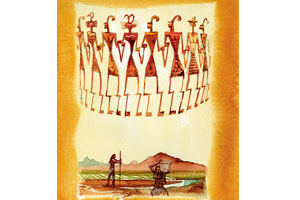 What If They’d Had a John Deere?
What If They’d Had a John Deere?
The Hohokam lived in the Salt River Valley from about 300 BC to AD 1450. They had a sophisticated 1,000-mile system of canals emanating from the Salt River. All this, without the aid of metal or even a wheel. In spite of these handicaps, their crops flourished and they had time for art, jewelry and sports (huge ball courts). Some 50,000 Hohokams called this area home for twice as long as the modern-day farmer has been here. In fact, it took Phoenix well into the 20th century to get back to 50,000 population.
The First White Man in Arizona Was a Black Man
An African slave, Esteban de Dorantes, or Estevanico, helped spread the idea of Seven Cities of Gold in Spain. Consequently, he was sent on an expedition, in 1539, into northern Mexico, headed by Marcos de Niza who took Esteban as a guide. Niza sent Estevanico to scout ahead and the slave was well received, especially by the women who admired his physique and charm (Esteban learned languages, quickly endearing him to those he met). Unfortunately, his sex appeal went to his head and he was killed by Zunis.
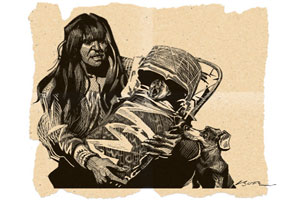 Not Bad for a Chronic Yawner
Not Bad for a Chronic Yawner
In the Apache custom, his parents named him Goyathlay for a particular trait: “he who yawns.” Born circa 1829 near the headwaters of the Gila River, he grew up to be a warrior and struck fear into his Spanish-speaking adversaries, who noted he fought like San Jerónimo. The nickname stuck, and he became known as Geronimo.
Shore Leave
In 1846, when the Mormon Battalion crossed Arizona during the Mexican-American War, Lt. George Stoneman decided to test the navigability of the Gila. His men built a raft and loaded it with supplies. The young lieutenant cast off into the Gila and floated a short distance before the naval craft sank. Like any good skipper, Stoneman went down with his ship…then walked ashore.
 Hi Jolly
Hi Jolly
Hadji Ali reportedly hailed from Syria and arrived in Texas in 1856 to escort a shipment of camels for use by the U.S. Army. In 1857, leaving from Texas’s Camp Verde, he crossed the desert with Lt. Edward Fitzgerald Beale and his camel experiment to open a wagon road across Arizona from Fort Defiance to the Colorado River at Fort Mohave to Fort Tejon in California. He became known far and wide as Hi Jolly, a corruption of Hadji Ali. Hi Jolly then prospected and became a part-time scout for the army. Returning to Arizona, he was naturalized as Philip Tedro in 1880 in Tucson, where he married and had two daughters. In 1889 he resumed prospecting near Quartzsite. He died there, in 1902, and a monument to his irrepressible soul was erected there in 1935.
Damned Babies
The future “Father of Arizona,” Charles Poston, arrived in the little adobe pueblo of Tubac in 1856 where he became the magistrate, alcalde or just “El Cadi” to the citizens. Tubac, in those days, had no Catholic Church, so he performed marriages, baptized babies and even granted divorces. When the bishop in Santa Fe discovered what was happening, he dispatched a priest to Tubac to declare all marriages null and void. The resulting civil unrest among the citizens was quickly resolved when Poston and the priest reached an agreement. The “El Cadi” would make a donation to the church and in return the priest would bless the marriages and make all the little Carlos and Carlottas legitimate again.
Pie Town
Allen Street, in Tombstone, is not named for a famous gunfighter, but for a man who got his start selling pies. John Pie Allen began baking and selling pies in Arizona in 1857 and earned the nickname “Pie Allen.” He eventually opened a bakery in Tombstone in 1879 on the southwest corner of Fourth and Allen Streets.
The Beer Border
Lots of early Arizona land surveying involved wingdinging. A wingding is when you stand at a geographical point, slam your palms together and wherever your joined palms point to, that’s the route to take. See that wingdinged, catty-wampus angle at the bottom of Arizona? According to legend, after the Treaty of Guadalupe Hidalgo in 1848, a group of surveyors was supposed to map out a new boundary by heading west from New Mexico to the Gulf of California, thus ensuring Arizona would have a bona fide seaport. Unfortunately, when the surveyors got to Nogales, they heard there was a whole bunch of beer in Yuma (and besides it was kind of cold out). So, they made an executive decision, executed a wingding, turned their transit and pulled their chains toward Yuma. Remember, when it comes to Arizona landmarks, you always follow the beer.
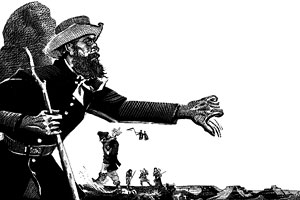 His Vision? Not So Grand
His Vision? Not So Grand
Lieutenant Joseph Ives explored Arizona’s waterways in 1858. Trekking to a remote canyon, with native guides, he made a bold prediction: “Ours has been the first, and will doubtless be the last, party of whites to visit this profitless locality.” The area was later named Grand Canyon National Park.
Placer Police
Colonel Jake Snively’s 1858 gold strike on the Gila River a few miles east of Yuma eventually drew Jack Swilling to the new boomtown of Gila City. Constant raids by Tonto Apache on the prospectors led to the forming of a militia called the Gila Rangers. The men elected Swilling leader. On January 7, 1860, while leading a punitive expedition against the Apache, Swilling and his Rangers came upon the Hassayampa River, previously unknown to white men. The area was too remote and dangerous to explore for gold, but Jack would return at a later date.
 Deadlines Missed
Deadlines Missed
On July 8, 1859, in Tubac, silver capitalist Sylvester Mowry and newspaper editor Edward Cross squared off with Burnside rifles at 40 paces. Cross took umbrage with Mowry amping up the population of the territory to encourage immigration. Yet on that windy day, both shooters missed. Witnesses reported: “No blood flowed.”
 Criminal Law
Criminal Law
Arizona has had three different Arizona Ranger law enforcement groups. The first Ranger group was created in 1860, the second in 1882 and the third in 1901. All three did their best to combat lawlessness, but they were all defeated by the Arizona Legislature, which wouldn’t pay them (1882) and finally voted them out of existence (1909), proving that it’s hard to beat crime when you “fight city hall.”
Chuckin’ Wagons
In July of 1862, a U.S. Army advance detachment entered Apache Pass where they were attacked by some 500 Apaches led by Mangas Coloradas and Cochise. Deploying several 12-pounder mountain howitzers, the artillery unit opened fire in earnest. The Apaches, who had never encountered artillery before, held their positions until nightfall, then retreated. Later, one of the Apaches reportedly remarked of the battle, “We did okay, until you started firing wagons at us.”
Map Quest
The first time Arizona was kicked in the teeth was when it tried to become its own territory separate from New Mexico, before the Civil War. Five times, Arizonans petitioned Washington for their own territory, and five times they were ignored. So they went over to the other side and twice voted to align themselves with the South, which finally took them in. Confederate President Jefferson Davis created the Confederate Territory of Arizona in early 1862. It was the first time the name “Arizona” appeared on any map. That finally got Washington’s attention, and President Abraham Lincoln swooped in on February 24, 1863, to create an Arizona Territory that was part of the Union.
 Loser Mountain
Loser Mountain
During the Civil War, Gen. Irvin McDowell lost the First Battle of Bull Run and then, defying all odds, lost the second Bull Run (although he was exonerated of full blame for the second). In spite of this he rose through the ranks, and his prominence as commander of the Department of the Pacific (1864-65) led to recognition of the general in central Arizona. The McDowell Mountains, Fort McDowell and McDowell Road were all named for this loser.
Divorce, Arizona Style
Divorces were hard to get in Arizona Territory—unless you knew a legislator! As weird as it sounds today, the legislature itself granted divorces to its pals. The First Territorial Legislature got things started in 1864 when House Member John G. Capron was granted an annulment and Fort Whipple’s post surgeon Elliot Coues, a divorce. The legislature finally got out of the divorce business in 1880.
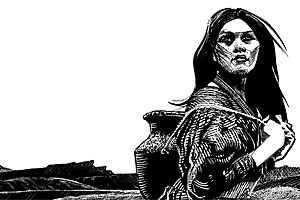 The Incredible Journey
The Incredible Journey
Captured by Sonoran mercenaries near Esqueda, Sonora, Mexico (south of present-day Douglas), in the mid-1860s, Dilcthe was sold into slavery and shipped to the Baja Peninsula, where she ended up as an indentured servant at a hacienda. She and several others escaped, outrunning and outsmarting the mounted search parties sent to track them down. Crossing the Colorado River near Yuma (she couldn’t swim), Dilcthe evaded ambush by Yuma raiders and made it to her Warm Springs Apache family. She had walked more than 1,000 miles. Through it all, she carried no map, no weapons and almost no provisions. What iron will she possessed!
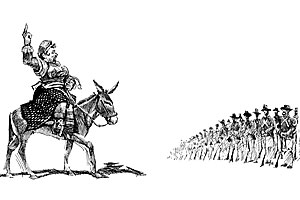 The Biggest Leg in Mexico
The Biggest Leg in Mexico
At six feet two and 200 pounds, red-headed camp follower Sarah Bowman was nicknamed the “Great Western,” after the largest steamship afloat in the 1830s. During the Mexican War, when told U.S. Army regulations required that a woman couldn’t travel with the troops unless she was married to one, she rode a donkey down the line shouting, “Who wants a wife with $15,000 and the biggest leg in Mexico?” Four husbands later, she died in Yuma of a spider bite in 1866; in 1890, her very large bones were removed to the Presidio of San Francisco in California.
Founders Flounder
Before 1860 no white person dared to travel north of the Gila River in Arizona. It was the home of the Yavapai and the Tonto Apaches, and they brooked no trespassers. Jack Swilling arrived in the Salt River Valley in 1867. Two other famous early pioneer white Arizonans in that region were Darrell Duppa and Charles Poston. (Duppa, born in France to English parents, had been educated in Europe before coming to the states. He is credited with coming up with the names of Phoenix and Tempe, both allusions to ancient history.) All three survived numerous fights with Indians, and all carried wounds from those encounters. All died poor, proving the old adage: Pioneers get the arrows, settlers get the land.
The Lost German?
Jacob Waltz, the legendary miner who came to Arizona in the 1860s and allegedly discovered a mine in the Superstition Mountains that has never been found, is known far and wide as the Lost Dutchman. Waltz was actually German.
 Against All Odds
Against All Odds
Cochise was perhaps the greatest chief of the Chiricahua Apaches. He fought his way through southeastern Arizona and into Mexico in the 1870s, killing, as he put it, “10 white men for every Indian I have lost.” Tired of fighting, Cochise negotiated for peace in 1872 and never fought again. He supposedly died of cancer on June 8, 1874, and his body is buried in a secret crevice in his Dragoon Stronghold within Arizona’s Coronado National Forest. In spite of his controversial reputation, the people of Arizona named a county after him a mere seven years after his death.
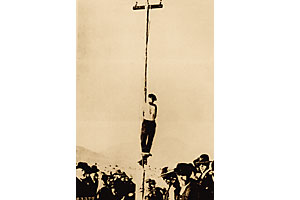 Pole Dancer: “Can You Hang Me Now?”
Pole Dancer: “Can You Hang Me Now?”
In 1884, John Heath was taken from the Tombstone jail by a Bisbee mob and hanged from a telegraph pole. Dr. George Goodfellow reported to the coroner’s jury that Heath: “. . . came to his death from emphysema of the lungs, which might have been, and probably was, caused by strangulation, self-inflicted or otherwise, as in accordance with the medical evidence.” The jury accepted his findings.
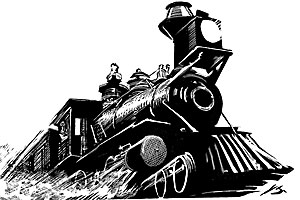 Climate Change Railroaded
Climate Change Railroaded
With the proliferation of railroad building in the early 1870s, federal reports (funded by the railroads themselves) contended that even the building of railroads increased rainfall. These same reports predicted that with the planting of more trees transported to desert areas like Arizona by train, “We are of the opinion that inside of five years owing to these changes the thermometer will never have occasion to go above the 95 degree mark.”
Hanging Around the Playground
On May 2, 1873, Arizona’s first legal hanging took place in Yuma, across the street from a schoolhouse. The teacher dismissed classes for the day.
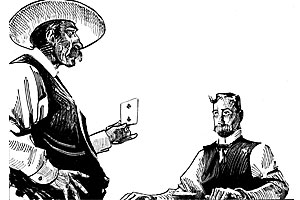 Show Low vs. a Straight Flush
Show Low vs. a Straight Flush
In 1875, two ranchers, Corydon Cooley and Marion Clark, decided the valley they lived in wasn’t big enough for the both of them. To see who would stay and who would leave, they played Seven Up, a popular game with the cowboys in which the lowest card won. After the last hand was dealt, Clark said, “If you can show low, you win.” Cooley turned over the deuce of clubs and replied, “Show low it is.” Most residents of Show Low are glad he didn’t call for a straight flush.
 Legendary Dish Washer
Legendary Dish Washer
In the spring of 1876, Henry Antrim worked as a busboy at the Hotel de Luna at the edge of Camp Grant, Arizona Territory. He also moonlighted as a horse thief. In 1877, when a town bully called Henry a “pimp” and a “son of a bitch,” the kid shot his first man. He later changed his name to Billy Bonney and became known as Billy the Kid.
Not Everyone Loved Arizona
John C. Fremont, appointed as Arizona’s territorial governor in 1878, spent most of his career exploring California. When he was informed he had to reside in Arizona, or resign. He resigned.
Steaming into the Future
Few innovations changed the face of Arizona more than the arrival of the first steam engine in Tucson in March of 1880. Travel time for passengers going to Los Angeles, California, was reduced from five days to less than one, with the cost dropping by two thirds. Freight shipments that previously took three months now arrived in four days, and freight charges dropped to one tenth of what steamer or wagon freighters charged. Better quality lumber arrived along with special imports like El Paso pressed brick. More important, the railroad brought people from all over the world to live and to visit, spelling the end of the frontier in Arizona. Unfortunately, some of Tucson’s biggest businesses were doomed by the arrival of trains, including the freighting company Tully, Ochoa & Co. Their stage drivers were quick to say to anyone who would listen, “Many of my passengers don’t like the train. It scares them.”
But It’s a Dry Hell
Arizona has been compared to hell for a long time. In the 1870s when the “Father of Arizona” Charles Poston tried to discuss territorial status for Arizona with a congressman, the senator said, “Oh, yes, I have heard of that country—it is just like hell—all it lacks is water and good society.” When Gen. William Sherman was told in the 1880s that all Arizona needed was more water and less heat, he answered, “that’s all Hell needs.” By the way, Sherman also said, in response to cries for a war with Mexico over border depredations, that the only war he was going to fight with Mexico was one that forced them to take back Arizona and New Mexico. To hell, you say?
 Drunken Loser Gets the Seal of Approval
Drunken Loser Gets the Seal of Approval
Like most Arizona prospectors in the 1870s, George Warren wanted to get rich quick. He had some luck (the Warren Mining District and town of Warren is named for him). But he suffered from bad judgment (on July 4, 1880, he bet a friend he could outrun a horse and ended up losing his stake in Bisbee’s Copper Queen Mine). And he had a drinking problem. Oh, and late in life, he was judged insane. So it’s perhaps fitting that his likeness is on the seal of the great state of Arizona.
 Curly’s Bill
Curly’s Bill
Legendary outlaw Curly Bill Brocius had a perverse sense of humor. Around 1880, he broke into a dance on the San Pedro and at gunpoint forced everyone to strip naked and dance for his amusement. In Galeyville, he once went into a restaurant, ordered a meal, then placed a six-shooter on each side of his plate and ordered everyone to wait until he was through before they could leave. When he finished, Brocius laid his head down upon his arms and fell asleep. Everyone was afraid to move. Some time later, Bill awoke, paid for everyone’s meal and left.
Touched by an Angel
When Nellie Cashman arrived in Tombstone in 1880, her principal business was running a boarding house. But in a town without a hospital, she extended her self-sacrificing generosity to injured miners, many times hosting plays to raise funds for their care. Newspaper editor John Clum recalled one such prospector who “had been sinking a shaft single handed and had fallen into the shaft and broken both legs…. Nellie rushed to his aid and within a day or two secured nearly $500 for his care and comfort.” She also put herself in danger, like the time strikers had planned to kidnap and hang E.B. Gage, the superintendent of the Grand Central Mining Company. Nellie fearlessly ferried Gage in a buggy to the railway station in Benson, so he could escape on a train to Tucson. On top of all that, after the death of her sister, she was raising Fanny’s five children in the wilds of Tombstone. It’s easy to see why Clum called Nellie a “thoroughbred pioneer and seasoned ‘sourdough’” who “had no rival among her own sex, and there were few, if any, among the male adventurers who could qualify in her class.”
 Wyatt Screams for Ice Cream
Wyatt Screams for Ice Cream
Wyatt Earp enjoyed eating ice cream in Tombstone. For the Lotta Crabtree estate case, Wyatt testified in 1926, “I met her [Jack Crabtree’s wife]…at an ice cream parlor…on Fourth Street between Allen and Fremont….I used to go there pretty often. I liked ice cream….” The ice cream parlor Wyatt is referring to ran an ad in the Tombstone Daily Nugget in 1881. The idea of Wyatt and Doc Holliday ordering ice cream in the wildest camp in the West (“I’ll try the Huckleberry!”) is a sight to imagine. Wyatt, his brothers and Doc walked by this very “saloon” on their way to the gunfight.
 Cold-Blooded Roommates
Cold-Blooded Roommates
In the fall of 1880, Doc Holliday shared a room in Prescott with John J. Gosper, the soon-to-be acting governor of Arizona. Historians want to know how Holliday, the deadly dentist and gambler, could have sunk so low as to room with a politician.
Town Too Tony to Die
According to George Parsons’ journal the first circus (Ryland’s) landed in Tombstone on September 22, 1880. Parsons also reports going to see Prof. Taylor’s magic show on May 5, 1881. In addition to circuses and theatre troupes, horse racing and baseball games, a municipal swimming pool opened in 1883, making the mining town a very cosmopolitan place.
 In Vino Veritas
In Vino Veritas
We have this image of Old West saloons serving rotgut, but in wild Tombstone, Kelly’s Wine House served 26 wines imported from Europe and had its own microbrewery. Ike Clanton spent two hours in this fancy joint on the evening of October 25, 1881, tuning up no doubt for the O.K. Corral gunfight the next day. Makes you wonder if he had ever even heard of rotgut.
 Chip On His Shoulder . . .and His Back . . .and His Elbow
Chip On His Shoulder . . .and His Back . . .and His Elbow
San Simon cowboy Dick Lloyd was well known in southern Arizona for his “tall bucking” (cowboy slang for riding a bronc in high style). Unfortunately, he got drunk in Maxey (near Safford) in March 1881 and rode his horse into O’Neil and Franklin’s Saloon, where Curly Bill Brocius, John Ringo and other cowboys were playing cards. Perturbed, they unlimbered their six-shooters and plugged Lloyd, dropping him to the floor of the saloon. According to legend, the cowboys continued their card game, tossing winnings onto the body to help defray his funeral expenses.
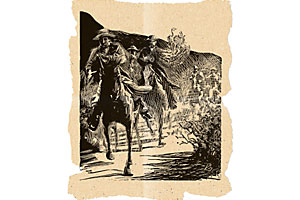 Farewell to Arm
Farewell to Arm
On the night of December 28, 1881, City Marshal Virgil Earp was ambushed and hit with buckshot while he was crossing the intersection of Fifth and Allen Streets in Tombstone. His left arm was shattered. Doctors had to saw off his elbow, so his arm now hung limp without a bone connection. The tough old lawman got around fine. In fact, in 1887, Virgil joined a Tombstone posse looking for train robbers. He freaked out a Mexican tracker when an early morning gallop showcased Virgil’s lack of an elbow joint, his arm flailing in all directions. Everyone had a good laugh about that one.
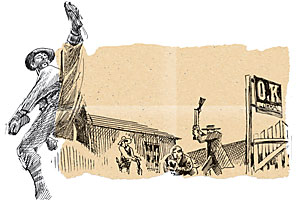 Spitballs at the O.K. Corral
Spitballs at the O.K. Corral
Thanks to Rev. Endicott Peabody, mere months after the so-called Gunfight at the O.K. Corral in October 1881, Tombstone formed a baseball team and began playing other mining camps in the area. The game caught on, and many baseball rivalries were born, some of them existing to this very day. In 1929, the Detroit Tigers were the first major league team to come to Arizona for spring training.
 Fynn Flam Man
Fynn Flam Man
Deputy Jim Flynn ran unsuccessfully for city marshal of Tombstone on January 3, 1882. Two weeks later, working as a policeman, he disarmed and arrested three of the deadliest gunmen on the frontier: John Ringo, Doc Holliday and Wyatt Earp, who were faced off on Allen Street and egging each other on for an O.K. Corral rematch. Except as a footnote, Jim Flynn is totally forgotten.
Double Take
On August 30, 1882, two masked men held up the Black Canyon stagecoach traveling from Phoenix to Prescott. While the robbery was in progress, another stage arrived, going in the opposite direction; it too was robbed. It was two-for-one for the robbers who escaped.
Reavis & Butthead
In 1880, James Addison Reavis claimed to be the heir to an old Spanish land grant that made him the rightful owner of a huge tract of land that included the Valley of the Sun (Phoenix) and the rich mining districts of Globe, Clifton-Morenci and Silver City, New Mexico. He showed up in Arizona with his wife, who he claimed was the sole surviving member of the once-powerful Peralta family. Reavis claimed that the ruins at Casa Grande were once their hacienda. He also demanded payment from businesses, railroads and mining companies. While he was making his case in federal claims court in Santa Fe, his claim sounded legitimate, and it appeared he would soon be the wealthiest man in America. At the last minute, government investigators discovered that some of the documents used modern inks that were not available centuries before. The Peralta woman was just some poor woman he found in California and talked her into marrying him. The land grant was rejected, and Reavis was sent to prison for perjury. But he inspired an entire class of Arizona swindlers known as land developers who would change the face of the state.
The Nutty Professor
An 1885 duel on Prescott’s Whiskey Row began when a former frontier scout, now legislator, Clay Beauford changed his name to Welford C. Bridwell, which incurred the wrath of a local Frenchman known as the “Professor.” The Frenchman confronted Bridwell on Whiskey Row one day and chastised him for denying his French heritage. The old scout, a man of few words, poked him in the nose. French pride momentarily clouded the professor’s rationality, and he challenged the legislator to a duel. Bridwell called out six-shooters for the weapons. Realizing his predicament the Frenchman insisted they use French sabers instead. He knew there were none within at least a thousand miles. Fortunately, both contestants and bystanders saw the humor in the event, and all retired to the Palace Saloon for some liquid refreshment.
Border Crosser
No other governor has ever entered office under more peculiar circumstances than Conrad Zulick did in 1885. At the time of his selection, Mexican laborers were holding Zulick under house arrest at one of his mines in Nacozari. U.S. Marshal W.K. Meade dispatched a former Army scout, Doc Donovan, who was familiar with northern Mexico from his days chasing Geronimo, to slip across the border in the middle of the night and fetch the governor. Donovan crept past the sleeping guard, snatched the surprised Zulick and they rode for the border. When they arrived in Tombstone a large crowd of well-wishers gathered to welcome the new governor.
Beach! Beach! Beach!
A desert state with a seaport? Yes, starting in 1885, the territory began asking Congress to buy more of Mexico to give Arizona an ocean view. Arizona didn’t give up until 1936. Some bad ideas just die hard.
 Pushing Buttons
Pushing Buttons
After his final surrender in 1886, the Apache leader Geronimo became quite in demand at expositions, parades and fairs. He quickly caught on to the marketing potential and was soon charging for autographs, signed photos, even selling his head gear and the buttons off his clothing as souvenirs. The budding capitalist was so successful, by the time he died, in 1909, he had amassed $10,000 in his bank account. Imagine what Geronimo could have done on Wall Street today.
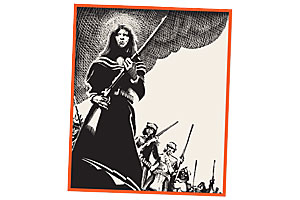 Chosen Lozen
Chosen Lozen
She’s been called “America’s greatest guerrilla fighter” and the “Apache Joan of Arc,” but few have heard of Arizona-born Lozen, a skilled warrior, prophet, healer and midwife who was the “right hand” of her brother, Chief Victorio, and in the end was exiled with Geronimo. She, too, became a prisoner of war, dying of tuberculosis sometime after 1887.
Around the Block in 80 Days
In the 1880s, legislators could get reimbursed 15¢ a mile, so Yavapai County delegate Dr. Frank Ainsworth claimed $225 for travel (1,500 miles), although he lived only a few blocks from the Capitol. He put in from the farthest point in huge Yavapai County.
Reverse Psychology
The first train robbery in Arizona history occurred on April 27, 1887, at Pantano, about 20 miles east of Tucson. After getting their loot, the robbers disconnected the engine from the rest of the train, climbed aboard the locomotive and were last seen heading toward Tucson. When Doc Smart, the leader of the gang, was later caught for another robbery, he admitted how they had escaped the posse: the outlaws rode the locomotive to the outskirts of Tucson, put the engine in reverse, then jumped off and walked into town. The engine headed down the tracks until it ran out of steam. While the posse was scouring the desert looking for tracks, the outlaws were living it up in Tucson.
 Wiskey Rules
Wiskey Rules
In 1888, New York illustrator extraordinaire Frederic Remington accompanied the 10th Cavalry Buffalo Soldiers in Arizona while on assignment for The Century Illustrated Monthly Magazine. For two weeks, he traveled from Fort Grant to San Carlos, drawing soldiers and the Apaches. Of the ruling class in the territory he posited: “Young men full of enthusiasm, old men full of whiskey.”
 Super Troopers
Super Troopers
There are two theories on how black troops stationed in 19th-century Arizona (first posted here in 1888) became known as “Buffalo Soldiers.” American Indians called the black troops “Buffalo Soldiers” because of their dark curly hair, which resembled a buffalo’s coat. The other theory is that the Plains Indians spread the word of a new type of soldier, “who fought like a cornered buffalo.” Either way, the Buffalo Soldiers were instrumental in helping to make Arizona a state.
The Ayes Have it
There’s an enduring legend surrounding Maricopa County getting the capital in 1889 that concerns a Yavapai County legislator with a glass eye and a good time gal named Kissing Jenny. It seems this legislator had a habit of heading over to Whiskey Row each day after the group convened. After a few drinks, he would walk to the “District” on Walnut Creek, where he spent the evening with Kissing Jenny. After he blew out the candle, he always placed his glass eye in a glass of water beside the bed. Knowing their colleague from Yavapai County was extremely vain and would never be seen in public without the glass eye, some Maricopa County legislators lured Jenny into a scheme of theirs. They convinced Jenny to take a drink that night, quaffing down both water and glass eye. The next morning, a vote was going to be taken regarding the location of the capital. The Yavapai County delegates, desperately needing every vote, went in search of their missing peer. Finding him at Jenny’s, they could neither convince the lady to “pass” the eye to them (no pun intended) nor persuade the legislator to accompany them. And that is how Phoenix became the capital of Arizona.
The Winged Dragon of Cochise County
The Tombstone Epitaph ran an article on April 26, 1890, about two cowboys out in the desert between the Huachuca and Whetstone Mountains who came upon a “winged monster resembling a huge alligator with an extremely elongated tail and an immense pair of wings.” The creature could only fly short distances, so the cowboys chased it for several miles before finally getting close enough to shoot it. The wounded dragon then turned on them, but it was too exhausted to make a fight. The cowboys finished it off with their Winchesters. The creature’s snake-like body was four feet wide and 92 feet long with a wingspan of 160 feet. Its eight-foot-long head resembled an alligator’s. The eyes were large as dinner plates. The beak was about eight feet long and had sharp teeth, while the feet had huge claws. To prove it had not all been a spoof, the cowboys cut off a wing tip. The newspaper reported the creature’s corpse was to be sent to a museum. But nobody followed up on this bizarre story, nor did anyone produce a photograph of the creature.
 Mountain Do
Mountain Do
In 1890, Walt Rigney ran a saloon on the Mogollon Rim. His hair stuck out like a pine bough, so the soldiers who frequented the saloon called him Ol’ Pinetop. When the Apache Wars came to a close, people began building cabins around Ol’ Pinetop’s saloon and eventually a town was born. The citizens named the town Pinetop, not because it was located amidst the largest stand of Ponderosa Pine in the world, but for a tall, bushy-headed bartender.
‘Nuff Riders?
In 1898, Arizona became the first in the nation to sign up for a “cowboy cavalry” for the Spanish-American War. Prescott, which had about 2,000 residents then, saw 1,000 willing volunteers—the same kind of response came from the booming mining towns of Jerome and Bisbee. These men became the “1st United States Volunteer Cavalry,” led by Lt. Col. Theodore Roosevelt, who renamed them his “Rough Riders.”
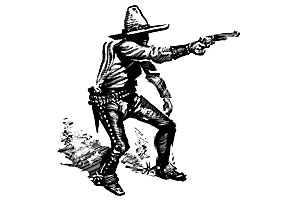 The Hairy One Hangs
The Hairy One Hangs
Sonoran bandito, Augustine Chacon, alias Peludo (“The Hairy One”), robbed and killed in Arizona, and then hid out in the Sierra Madres until his capture in 1896. Scheduled to hang for the murder of a deputy, Pablo Salcido of Morenci, Chacon was found guilty by a jury at Solomonville and sentenced to hang. Thanks to a hacksaw smuggled into the jail inside a bible and a “lady friend” who lured the night guard away, he escaped. In 1902, the Arizona Rangers slipped into Mexico and captured him. This time, he was successfully hanged, on November 21, 1902, at Solomonville.
A Bullet for Buckey
After a stint at The Tombstone Epitaph in 1880, Buckey O’Neill moved to Prescott in 1882 where he served as a court reporter and founded his own newspaper, Hoof and Horn, a paper for the livestock industry. He served as a judge and was elected sheriff in 1888, rounding up four train robbers. One of his best friends was Tom Horn. In 1897, O’Neill was elected mayor of Prescott. With the fever of the Spanish-American War spreading across the country, O’Neill and 999 other Prescott volunteers joined Teddy Roosevelt’s Rough Riders. On July 1, 1898, O’Neill was talking to his troops at the foot of Kettle Hill when one of his troopers advised him to duck down. His last words were, “The Spanish bullet is not made that will kill me.”
Playing Both Sides Against the Middle
Burt Alvord, constable at Willcox, decided to increase his wealth by robbing a train. Since he wasn’t the sharpest knife in the drawer, he figured nobody would think he was smart enough to rob a train. He recruited three friends, Billy Stiles, Bill Downing and Matt Burts. They all met in the back room at Schweitzer’s Saloon in Willcox on September 9, 1899, to play poker. The boys then climbed out a window, mounted their horses and rode for Cochise Station a few miles west of town. Back at the saloon a porter had been bribed to bring drinks from time to time and comment casually how much whiskey the boys were consuming. This would establish an alibi in case Wells Fargo detectives started asking questions. The robbery went off as planned. Legend has it they got away with $30,000, but the actual amount was closer to $3,000. The train backed down to Willcox to sound the alarm. “Where’s the marshal?” the engineer wanted to know. “He’s over at the saloon playing poker,” he was told. When told there had been a train robbery, Burt shouted, “We’ve got to raise a posse and go after them.” Pointing at Downing, Stiles and Burts, he said, “I deputize you, you and you.” The four men rode out of town at a gallop in search of the train robbers. It marked the first time, maybe the only time, in history that the posse pursuing the train robbers were the train robbers.
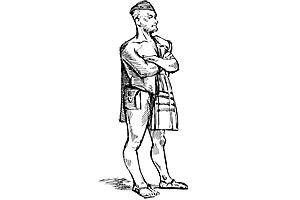 OMG
OMG
He showed up in Tombstone in the summer of 1891, without a gun, without a name and without clothes. The bronzed visitor insisted on being called “O Homo.” Traveling through the country stark naked, he had already been arrested some 40 times prior, but no one had thrown him in jail like they had in Tombstone. While O Homo served his 30-day sentence, women wrote from as far away as California, offering to marry him. Camillus S. Fly paid him $5 for a sitting at his Fremont Street gallery; he took three photos and sold them for $1 a piece. O Homo vanished after his release. Or, did he? By October, Tombstone papers were reporting O Homo had committed suicide in Los Angeles.
 Highwaywoman
Highwaywoman
The last stagecoach heist in America was pulled off by Arizona Territory’s “bad girl,” Pearl Hart, in 1899. Hart masqueraded as a man when she and her boyfriend, Joe Boot, laid in wait near Globe on May 29 and robbed stage driver Henry Bacon and his three passengers. She took their cash–$431.20–a gold watch and their guns, but left each with $1 to buy supper. After her arrest, she poked fun at how easy it was to rob armed men. She made national headlines and became a cause célébre, objecting to a trial under laws that women had no hand in writing. Although she’d confessed to the heist, her trial jury acquitted her! The judge was so furious, he quickly retried her for stealing one of the pistols. She went to Yuma Territorial Prison—the only female inmate—but then was mysteriously paroled by Territorial Gov. A.O. Brodie on December 15, 1902, and given a train ticket out of town. She either left the state for good or lived around Globe until 1955, depending on whom you believe.
Nude Dude
During the early 1900s, Rufus Nephew, a.k.a. Climax Jim, was one of the most notorious horse thieves in Arizona. Lawmen caught him one day and hauled him into the Springerville jail. Realizing Rufus needed a bath, they gave him soap and a brush, and pointed him to a horse trough to bathe. Just as he was getting into the water, Rufus saw a fine looking horse tied to a hitching post. Without taking time to get dressed, he ran to the horse, jumped on and rode it down Springerville’s main street toward the mountains south of town. The town of Eagar lies between Springerville and the mountains, so he had no choice but to ride bare naked down their main street too. Everyone knows the story of Lady Godiva riding a horse in the nude down the street in Coventry, but Arizona can top that one. Rufus Nephew rode naked down the main streets of two towns.
A “Faultless” Figure
Arizona authorities reported 22 train robberies in the territory in 1902. Lawmen, including the Arizona Rangers, rounded up and shot down more than a few, including one bad man named Tom King who had been killed in a holdup on the border south of Tombstone. When it came time for burial, Mr. King turned out to be a woman, identified as Flora Quick, alias Flora Mundis, Chinese Dot. She had evidently started her own gang around Clifton. There were clues to her sex on Tom King’s reward circular: figure is “faultless.” No doubt.
Shoot ‘em, Groom ‘em, Entomb ‘em
George Ruffner arrived in Prescott in 1882 and in the years that followed was a cowboy, freighter, rancher and, in 1894, sheriff of Yavapai County. He went on to serve five non-contiguous terms as sheriff until he died in office in 1933. He also helped organize the world famous Prescott rodeo in 1888. In 1903 he won a funeral home in a faro game at the Palace Saloon. From that day hence Sheriff Ruffner could offer taxpayers a package deal: he could shoot the bad guy, embalm him and bury him.
Capitol on Wheels: Strange Bedfellows
The first U.S. capital of Arizona was housed at Fort Whipple in 1863, but it was temporary while the permanent capital at nearby Prescott could get up to speed. Tucson, which had sided with the South in the recent Civil War, was livid that an upstart Yankee town had stolen its rightful place in the sun, and finally, after a payoff, the capital was moved to the Old Pueblo in 1867. Prescott editor, John Marion, a staunch Democrat, was so incensed at Republicans engineering the move to Tucson in 1867, that he supported the Democratic candidate for county attorney despite the fact the rascal had run off with his wife. Through shenanigans of its own, Prescott got the capital back in 1877, but in the 1880s Phoenix overtook both previous capitals in population and prestige (Phoenix had been hosting the Territorial Fair since 1884), and the “Capitol on Wheels” moved to the Valley of the Sun in 1889.
 The Thieving Thirteenth Sets the Bar
The Thieving Thirteenth Sets the Bar
On the table at the 13th Territorial Legislature (1885) were two plums: an insane asylum and a university. The delegates from south of the flooding Salt River had to take the train to LA then back across on the Santa Fe and down to Prescott, the state capital. By the time they arrived, all the good pork was taken and Tucson got the paltry university (“Who ever heard of a professor buying a drink?” went the local logic), while Phoenix got the coveted insane asylum. Fistfights and padded expense accounts ensued, proving that Arizona has long been a cantankerous place.
 A Smashing Adventure
A Smashing Adventure
In 1874, newlywed Martha Summerhayes accompanied her soldier husband on a grueling three-month journey from Fort Russell, Wyoming, to Arizona, where he had been transferred. The couple’s plan was to travel by train to San Francisco, California; by packet to Cabo San Lucas & Guaymas; by steamer to Yuma, Arizona, and Fort Mohave; and finally by wagon (he walked) to Fort Apache. While at the mouth of the Colorado River, where they were all waiting for the wind to die down so that they could board the steamboat, three soldiers died from the heat (they were wearing wool uniforms in 122-degree heat!) After finally making the transition, they met the soldiers and wives coming out of Arizona. Martha remarked: “The women’s clothes looked ridiculously old-fashioned, and I wondered if I should look that way when my time came to leave Arizona.” (She would.) They traveled past Forts Whipple and Verde, up the Mogollon Rim and on to the lonely outpost called Fort Apache. Pregnant with her first child, Martha unpacked, then ventured out to see what the other wives were doing. To her surprise, she found a young lieutenant’s wife playing tennis. Yes, tennis in the wilds of Arizona in 1874. Smashing!
Dead Drunk
Around 1:30 a.m. on Saturday, April 8, 1905, two cowboys, John Shaw and Bill Smythe, walked into the Wigwam Saloon in Winslow, bellied up to the bar and ordered a couple of drinks. They noticed a dice game going on and a few hundred dollars on the table. They pulled their guns, took the money and ran toward the train yards, leaving a trail of silver dollars. A posse caught up with them at Canyon Diablo. Smythe was captured, but Shaw was killed and buried on the spot. The following evening the Hashknife cowboys at the Wigwam were discussing the fact that Shaw should have had a chance to finish his drink. About 15 of them headed for Canyon Diablo—accompanied by a bottle of whiskey and a Kodak box camera—where they dug up Shaw. He was actually wearing a mischievous smile when they propped him up, gave him a drink and took his photo.
Hall Pass
In 1909, Sharlot Hall was so popular that people wanted to name her state historian. The legislature tried to bar any women from holding office. The law was actually not repealed until 1988; even so, Arizona has been the only state that elected women to five of its top offices.
Unwanted Illegals
They provided cheap labor, and they were blamed for white unemployment. Rampant racial sentiment in the U.S. would result in an 1882 exclusion act, which gave rise to the first great wave of commercial human smuggling along the Arizona-Mexico border. Who were these laborers? The Chinese. Arizona border guards, like Jeff Milton, did their best to keep the “coolies” out.
The Five Cs
Since 1910, Arizona has been the copper capital of America. In the early days of Arizona, boosters came up with the five Cs to describe the state’s economic strengths: Copper, Cotton, Citrus, Cattle and Climate. Given our outrageous history, that last one should be changed to Crazy.
Big Valley
After the dedication of the Roosevelt Dam in 1911, Teddy Roosevelt gave a speech at Old Main college campus at Tempe, in which he predicted the population of the Valley might reach 100,000 someday. Today it’s at 4.2 million and counting.
Total Recall
“Do not include recall in your constitution,” President William Howard Taft warned; Arizona Territory ignored him. He vetoed the constitution and wouldn’t let Arizona become a state, so the folks back home took the recall out. Yay, Statehood! First election after statehood, they reinstated recall.
 Not-So-Gentle Tamers
Not-So-Gentle Tamers
Whether they were wrangling ornery kids, or dispatching hogs, chickens, scorpions and rattlesnakes, the women who lived in Arizona Territory had to be tough. Sarah Butler York, who had traveled with her daughters to meet her husband in Gila Valley in 1877, welcomed the challenge, saying: “A rattlesnake is a more honest enemy, because he, at least, warns one before striking.”
 Legend of Red Ghost
Legend of Red Ghost
In 1893, a ranchwoman left her cabin near Eagle Creek in southeastern Arizona to fetch water; while doing so, she was ferociously attacked by a strange creature and killed. Eyewitnesses claimed they saw a huge, reddish beast with a skeleton on its back. Other folks soon reported attacks by this beast. Finally, Salt River rancher Cyrus Hamblin got close enough to identify Red Ghost as a camel with a human skeleton strapped on its back. The legend grew, until a rancher awoke one morning and found Red Ghost grazing in his garden; he shot it dead. On its back, the camel had deep scars made by rawhide strips used to tie human cargo. How the human body came to be attached to its back remains a mystery.

Arizona Rides Tall in the Saddle
The first film made in Arizona was a Western called The Sleeper, in 1912. There would be many more to follow.
 Master Cupid
Master Cupid
Lots of wonderful things happened on Statehood Day, February 14, 1912. There were parades and fireworks and cannons blaring, and in Phoenix, there was a sweet wedding of one of the city’s most popular couples, Miss Hazel Goldberg and Joseph Melczer. As the society columnist for the Arizona Republican noted: “Master Cupid was indeed present and gallantly guided the bridal party toward the alter.” He was a three-year-old boy wearing all white and carrying a bow and quiver of arrows. His name was Master Barry Goldwater, and this was his first public appearance.






